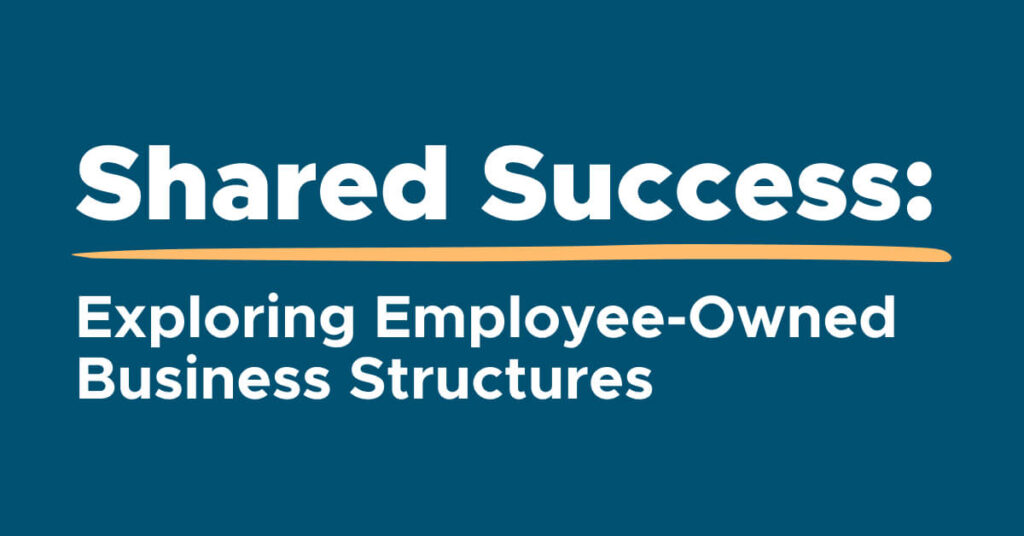
Aligning the interests of business leaders, employees, and shareholders can enhance the long-term health and success of any business. By setting up a structure where employees have a stake in the company’s ownership, businesses not only foster a sense of shared purpose and commitment, but also unlock a myriad of benefits. From enhanced employee engagement and productivity to greater innovation and resilience, the advantages of an employee-owned business extend far beyond financial incentives.
The following business structures have the potential to empower employees and create alignment of interests across the key stakeholders in your company.
Restricted Stock
Restricted stock gives employees shares of the company that are subject to certain restrictions, such as vesting periods or performance goals. Restricted stock can be an effective way of rewarding and retaining key employees.
In addition, capital gains from selling a business benefit from a preferential tax rate. For example, if the profit from the sale of your business qualifies as a long-term capital gain (assets held longer than one year), it would be taxed at a maximum of 20%. If the same profit was treated as ordinary income, it might be taxed at a rate as high as 37%.
However, restricted stock can have drawbacks, including:
- Creates tax liabilities for employees when they receive the shares, and as the restrictions come off.
- Reduces liquidity and flexibility, as employees must hold the shares for a certain period of time or until certain conditions are met.
Phantom Equity
Phantom equity provides a share of the profits or value of the company to employees, without actually giving them any shares or equity, hence the name “phantom” equity. For example, phantom equity can be structured as a deferred compensation plan or a profit sharing plan. It also has some advantages over restricted stock.
- Avoids tax implications and the dilution effects of granting actual shares or equity to employees.
- Allows employees to participate in the upside potential of the company, without exposing them to the downside risk.
Disadvantages of phantom equity.
- Lack of legal protection and enforceability of actual shares or equity, as the employees do not have any ownership rights or claims on the company’s assets.
- Dependence on the discretion and goodwill of the company, as the company can change or terminate the phantom equity plan at any time.
- Although the upfront tax treatment is better than restricted stock, the earnings on phantom equity are generally taxed as ordinary income.
Profits Interests
Profits interests give employees access to future profits or appreciation of the company, without giving them any ownership in the current value of the company. Profits interests can only be used with entities that are taxed as partnerships (typically partnerships or limited liability companies). Profits interests can have significant benefits:
- Tax-free for the employees when they receive their grants, if they meet certain requirements.
- Flexible and adaptable to the specific needs and goals of the company and the employees, as the profits interests can be based on different metrics and criteria.
- Compatible and complementary with other forms of employee ownership, as profits interest can be granted alongside or in lieu of other equity or compensation.
Profits interests can also have drawbacks:
- Valuation challenges – determining the value of profits interests can be challenging, particularly in rapidly growing or fluctuating businesses.
- Missteps in structuring or valuing profits interests can result in unexpected tax liabilities for both the company and the recipients.
Options
Options provide employees the opportunity to buy a certain number of shares at a predetermined price, within a specified period. Options can be an attractive way of incentivizing and rewarding employees, as they can benefit from the appreciation of the company’s value. Like other equity choices, options also have limitations:
- Expiration after a specified period, which may not align with the long-term goals and interests of the employees.
- Investment risk if the company’s value does not exceed the exercise price of the options.
- Tax liabilities for employees when they purchase the options, which can reduce their net gain.
Employee Stock Ownership Plan (ESOP)
An ESOP involves a trust that holds company shares on behalf of employees. The company can contribute shares to the trust, which then allocates those shares to employees based on specified criteria, including compensation, seniority, and other factors. Benefits of an ESOP include:
- Providing a tax-optimized way of transferring ownership and control of the company to employees, as the company can deduct contributions to the trust and the trust can defer the taxes on the shares.
- Creating a market for the shares of the company, as the trust can buy and sell shares from existing or departing owners or employees.
Noted challenges of an ESOP.
- Significant upfront investment and ongoing administration costs, as the company must set up and maintain the trust and the valuation of the shares.
- Limiting the diversification and liquidity of employees, as they must hold shares in the trust until they retire or leave the company.
- Introduction of a corporate trustee into the company’s governance.
Employee-owned businesses can help ensure alignment across all stakeholders, but most of these structures also have the potential downside of diluting company equity. Before setting up an employee-owned business structure, you should be confident that the benefits will outweigh the impact of dilution.
Contact us to explore how an employee-owned business structure might benefit your company.
About Cresset
Cresset is an independent, award-winning multi-family office and private investment firm with more than $235 billion in assets under management and advisement (as of 10/31/2025). Cresset serves the unique needs of entrepreneurs, CEO founders, wealth creators, executives, and partners, as well as high-net-worth and multi-generational families. Our goal is to deliver a new paradigm for wealth management, giving you time to pursue what matters to you most.
https://cressetcapital.com/disclosures/
